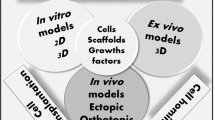Abstract
This review is aimed at providing a depiction of molecules and their topography which characterize native gingiva and PDL fibroblasts, to describe their function in tissue maintenance, and to discuss their possible modulation due to orthodontic tooth movement.
Maintenance of the human periodontium requires the balance of proliferation and differentiation in the respective tissues’ cells. Moreover, the cells must synthesize the extracellular matrix molecules and receptors that facilitate adhesion. To describe the molecules that contribute to periodontal tissue maintenance, we illustrate the localization of their expression and topography on frozen sections from native gingival tissue and primary cell cultures derived from periodontal ligament. In native gingival epithelium, proliferation is confined to basal and parabasal cells. Keratin K14, when used as structural marker, is visible in the entire epithelium, while K13, an indicator of early differentiation, is restricted to the suprabasal cell compartment. Vimentin indicates mesenchymal cells in the subgingival connective tissue. Concerning the matrix molecules, collagen type-IV is abundant at the epithelium-lamina propria interface, and fibronectin is apparent throughout the mesenchyme. The matrix receptor integrin β1 reveals a pericellular localization in basal and parabasal cells, while focal adhesion kinase p125FAK is seen pericellularly in all epithelial layers. Cultures of primary periodontal ligament (PDL) fibroblasts (PDL-F) reveal expression of vimentin, strong proliferation, synthesis and extracellular deposition of collagen type-I and fibronectin. The integrin subunits β1 and p125FAK are largely detectable at the cell periphery.
Zusammenfassung
Dieser Übersichtsartikel verfolgt das Ziel, die Moleküle sowie deren Topographie darzustellen, die die native Gingiva und PDL-Fibroblasten charakterisieren, ihre Funktion in der Aufrechterhaltung des Gewebes zu beschreiben und ihre mögliche Veränderung durch orthodontische Zahnbewegungen zu diskutieren.
Die Aufrechterhaltung des humanen Parodonts erfordert das Gleichgewicht von Proliferation und Differenzierung in den Zellen der entsprechenden Gewebe. Darüber hinaus müssen die Zellen extrazelluläre Matrix-Moleküle und Rezeptoren synthetisieren, die die Zelladhäsion ermöglichen. Um Moleküle zu beschreiben, die an der Aufrechterhaltung des humanen Parodonts beteiligt sind, stellen wir ihre Lokalisation und Topographie an Gefrierschnitten von nativem Gingiva-Gewebe und Primärkulturen von Zellen des Parodontalligaments dar. Im nativen Gingiva-Epithel ist die Proliferation auf die basalen und parabasalen Zellen beschränkt. Keratin K14 ist überall im Epithel sichtbar, wenn es als Strukturmarker verwendet wird, während K13, ein Marker für die frühe Zelldifferenzierung, auf das suprabasale Zellkompartiment beschränkt bleibt. Vimentin kennzeichnet die mesenchymalen Zellen im subgingivalen Bindegewebe. In Bezug auf die Matrix-Moleküle konzentriert sich Kollagen Typ-IV auf den Übergangsbereich von Epithel und Lamina propria, Fibronektin ist im gesamten Mesenchym vorhanden. Der Matrix-Rezeptor Integrin β1 zeigt eine perizelluläre Lokalisation in basalen sowie parabasalen Zellen, während die fokale Adhäsionskinase p125FAK perizellulär in allen Epithelschichten nachweisbar ist. Primärkulturen von Parodontalligament-(PDL)-Fibroblasten (PDL-F) zeigen eine Expression von Vimentin, eine starke Proliferation und die Synthese sowie extrazelluläre Deposition von Kollagen Typ-I und Fibronektin. Die Integrin-Untereinheit β1 und p125FAK sind größtenteils an der Zellperipherie nachweisbar.
Similar content being viewed by others
Author information
Authors and Affiliations
Corresponding author
Rights and permissions
About this article
Cite this article
Müssig, E., Tomakidi, P. & Steinberg, T. Molecules Contributing to the Maintenance of Periodontal Tissues. J Orofac Orthop 66, 422–433 (2005). https://doi.org/10.1007/s00056-005-0520-6
Received:
Accepted:
Issue Date:
DOI: https://doi.org/10.1007/s00056-005-0520-6




